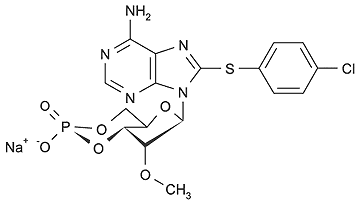Specific, potent and membrane permeant activator of the Epac cAMP receptor. Activates Epac1 and Epac2, the guanine nucleotide-exchange factors (GEFs) for the small GTPases Rap1 and Rap2. Does not activate protein kinase A (PKA), neither in vitro nor in vivo and is therefore a valuable tool to specifically discriminate between PKA- and Epac-mediated effects. Since a free 2'-ribose hydroxyl group in cyclic AMP is essential for stimulation of PKA, the methylated structure of 8-CPT-2'-O-Me-cAMP is an extremely poor PKA activator. Its high lipophilicity allows for good membrane permeability in most biosystems and its increased resistance towards phosphodiesterases prevents rapid hydrolysis.
Product Details
| Alternative Name: | 8-CPT-2'-O-Me-cAMP . Na |
| |
| Formula: | C17H16ClN5O6PS . Na |
| |
| MW: | 484.8 . 23.0 |
| |
| CAS: | 510774-50-2 |
| |
| Purity: | ≥98% (HPLC) |
| |
| Purity Detail: | Product is not sterile. |
| |
| Identity: | Determined by ESI-MS and UV. |
| |
| Appearance: | White to off-white crystalline powder. |
| |
| Solubility: | Soluble in water, aqueous buffers, DMSO, dimethyl formamide or methanol. |
| |
| Shipping: | Ambient Temperature |
| |
| Long Term Storage: | -20°C |
| |
| Handling: | Protect from light. Hygroscopic. |
| |
| Regulatory Status: | RUO - Research Use Only |
| |
Please mouse over
Product Literature References
Cyclic AMP induces integrin-mediated cell adhesion through Epac and Rap1 upon stimulation of the {beta}2-adrenergic receptor: S. Rangarajan, et al.; J. Cell Biol.
160, 487 (2003),
Abstract;
Epac-selective cAMP analog 8-pCPT-2'-O-Me-cAMP as a stimulus for Ca2+-induced Ca2+ release and exocytosis in pancreatic beta-cells: G. Kang, et al.; J. Biol. Chem.
278, 8279 (2003),
Abstract;
Full Text
A novel Epac-specific cAMP analogue demonstrates independent regulation of Rap1 and ERK: J.M. Enserink, et al.; Nat. Cell Biol.
4, 901 (2002),
Abstract;
Full Text
General Literature References
A family of cAMP-binding proteins that directly activate Rap1: H. Kawasaki, et al.; Science
282, 2275 (1998),
Abstract;
Epac is a Rap1 guanine-nucleotide-exchange factor directly activated by cyclic AMP: J. de Rooij, et al.; Nature
396, 474 (1998),
Abstract;
Signal transduction. New exchange, new target: J. Downward; Nature
396, 416 (1998), Comment,
Abstract;












